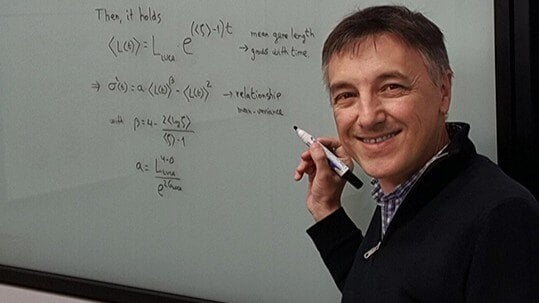The researcher of the Astronomical Observatory UV Fernando Ballesteros is one of the co-authors of the article that has published the prestigious magazine PNAS in which it explains how simple cells gave rise to complex ones. Research sheds light on what we are and why. Ballesteros points out, after this exhaustive study, that the appearance of complex life was inevitable
The appearance of eukaryotic organisms like humans was a necessary event in evolution. An international team of scientists co-led by the Astronomical Observatory UV, located in the scientific-academic area of the Science Park of the University of Valencia, has found that this emergence was a consequence of the genome’s increasing difficulty in finding longer and longer proteins as life became more complex, forcing a change in the genetic rules of play. This discovery, made after studying the genes of more than 33,000 species throughout the tree of life and now published in the prestigious PNAS magazine, provides a new understanding of the role of constraints in the origin of the complexity of organisms.
For much of Earth’s history, life was represented exclusively by simple cells without prokaryotic nuclei, such as bacteria, whose genomes are self-regulated by proteins. But "this mechanism simply reached a limit, a wall beyond which complexity could no longer grow," says Fernando Ballesteros, one of the co-authors and researcher at Astronomical Observatory UV. Studying the length distributions of genes and their associated proteins in several thousand organisms among bacteria, archaea, protists, plants, fungi and animals, they found a multiplicative growth process in genes that was doomed to a computational crisis, occurred 2.6 billion years ago, which led to the appearance of eukaryotes.
Studying the length distributions of genes and their associated proteins in several thousand organisms among bacteria, archaea, protists, plants, fungi and animals, they found a multiplicative growth process in genes that was doomed to a computational crisis, occurred 2.6 billion years ago, which led to the emergence of eukaryotes
The sophistication of the regulatory mechanism of the nucleus-free cells could be improved by increasing the size of the proteins, but only to a certain extent, beyond which the search for new proteins became computationally unfeasible. However, at the same time the average length of the genes encoding such proteins was growing exponentially throughout the entire history of life, tracing the increase in complexity of organisms. This evolutionary tension between genes that were growing and proteins that could no longer do so was resolved by an algorithmic phase transition, a type of transition characteristic of solution-seeking systems. After it, the genome changed its rules of operation, incorporating within genes sequences that did not encode proteins called introns. "This algorithmic phase transition allowed us to overcome the limitations of the prokaryotic regulatory system, encouraging the emergence of new functions and facilitating the cellular complexity necessary for multicellular life," concludes Enrique Muro, another of the authors and researcher at Johannes Gutenberg University in Mainz.
Researcher Lynn Margulis has already proposed the endosymbiotic theory that states that two cells joined in a symbiotic (mutually beneficial) relationship that allowed the development of mitochondria, the energy center of life. The research that is now being published is complementary because it sheds light on how, from symbiosis, a new system of genetic regulation could be developed to maintain this new level of cellular organization.
This strongly transdisciplinary research, combining biology, mathematics and physics, opens the door to a new understanding of the evolution and complexity of organisms, laying the foundations for new ways of studying a period of evolution as transcendent as it is unknown.
Source: UV News
‘The emergence of eukaryotes as an evolutionary algorithmic phase transition’. Enrique M. Muro, Fernando J. Ballesteros, Bartolo Luque y Jordi Bascompte. PNAS 2025. Doi: https://www.pnas.org/doi/10.1073/pnas.2422968122
--
Recent Posts


